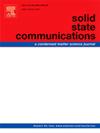Strain-dependent structural, electronic and magnetic properties of ordered double transition Cr2TiC2F2 MXene through first principles study
IF 2.4
4区 物理与天体物理
Q3 PHYSICS, CONDENSED MATTER
引用次数: 0
Abstract
MXenes, a rapidly emerging class of 2D materials, exhibit unique electronic, mechanical, and magnetic properties that make them highly promising for diverse technological applications. Among them, Cr-based MXenes hold particular significance due to their exceptional magnetic and electronic characteristics. In this study, we systematically investigate the strain-dependent electronic and magnetic properties of Cr2TiC2F2 MXene using density functional theory (DFT) calculations. Structural optimization reveals that Cr2TiC2F2 MXene possess an antiferromagnetic (AFM) ground-state configuration, with biaxial strain (−8 % to +8 %) applied to explore its impact on magnetic and electronic properties. Our results demonstrate that strain engineering significantly modulates the band gap and magnetic moments of Cr2TiC2F2 MXene. It is shown that the band gap decreases with increasing tensile and compressive strain and projected density of states (PDOS) calculations highlight that Cr has the main role in semiconductor antiferromagnetic Cr2TiC2F2 MXene. This comprehensive analysis not only enhances the understanding of strain effects on Cr-based MXenes but also paves the way for designing next-generation functional materials by leveraging strain-engineering techniques.
基于第一性原理研究有序双跃迁Cr2TiC2F2 MXene的应变相关结构、电子和磁性能
MXenes是一种迅速崛起的二维材料,具有独特的电子、机械和磁性,使其在各种技术应用中具有很大的前景。其中,cr基MXenes因其特殊的磁性和电子特性而具有特殊的意义。在本研究中,我们利用密度泛函理论(DFT)计算系统地研究了Cr2TiC2F2 MXene的应变相关电子和磁性能。结构优化表明,Cr2TiC2F2 MXene具有反铁磁(AFM)基态构型,应用双轴应变(- 8%至+ 8%)研究其对磁性和电子性能的影响。结果表明,应变工程可以显著调节Cr2TiC2F2 MXene的带隙和磁矩。结果表明,带隙随拉伸应变和压缩应变的增加而减小,PDOS计算表明Cr在半导体反铁磁Cr2TiC2F2 MXene中起主要作用。这种全面的分析不仅增强了对cr基MXenes应变效应的理解,而且为利用应变工程技术设计下一代功能材料铺平了道路。
本文章由计算机程序翻译,如有差异,请以英文原文为准。
求助全文
约1分钟内获得全文
求助全文
来源期刊

Solid State Communications
物理-物理:凝聚态物理
CiteScore
3.40
自引率
4.80%
发文量
287
审稿时长
51 days
期刊介绍:
Solid State Communications is an international medium for the publication of short communications and original research articles on significant developments in condensed matter science, giving scientists immediate access to important, recently completed work. The journal publishes original experimental and theoretical research on the physical and chemical properties of solids and other condensed systems and also on their preparation. The submission of manuscripts reporting research on the basic physics of materials science and devices, as well as of state-of-the-art microstructures and nanostructures, is encouraged.
A coherent quantitative treatment emphasizing new physics is expected rather than a simple accumulation of experimental data. Consistent with these aims, the short communications should be kept concise and short, usually not longer than six printed pages. The number of figures and tables should also be kept to a minimum. Solid State Communications now also welcomes original research articles without length restrictions.
The Fast-Track section of Solid State Communications is the venue for very rapid publication of short communications on significant developments in condensed matter science. The goal is to offer the broad condensed matter community quick and immediate access to publish recently completed papers in research areas that are rapidly evolving and in which there are developments with great potential impact.
 求助内容:
求助内容: 应助结果提醒方式:
应助结果提醒方式:


